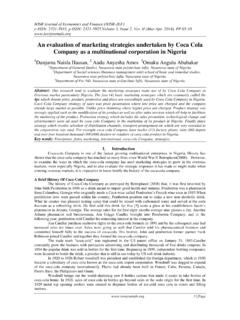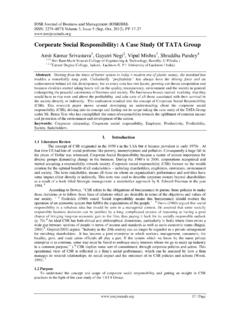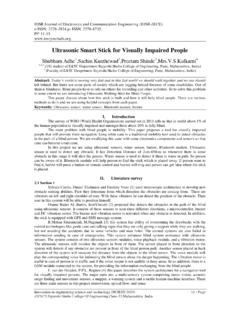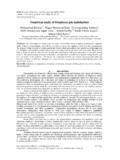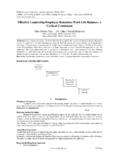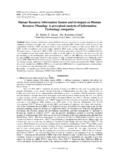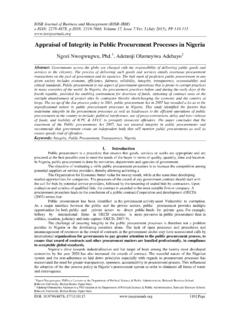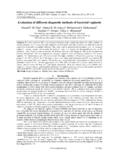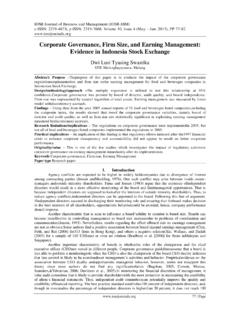Transcription of Improving Interpersonal Relationship in Workplaces
1 IOSR Journal of Research & Method in Education (IOSR-JRME) e-ISSN: 2320 7388,p-ISSN: 2320 737X Volume 5, Issue 6 Ver. II (Nov. - Dec. 2015), PP 115-125 DOI: 115 | Page Improving Interpersonal Relationship in Workplaces Obakpolo Patricia (Educational administration, and policies studies, Delta State university Abraka delta state, Nigeria) Abstract: Positive Interpersonal Relationship at work foster a variety of beneficial outcomes for individual and organization hence, this paper on Improving Interpersonal Relationship in workplace. This study is aimed at examining the need for Interpersonal Relationship in workplace. Three (3) research questions were raised and answered. Theoretical works were reviewed. The findings from the review were; (1) that employee s demographics and work environment can in a way affect Interpersonal Relationship in workplace if not properly managed.
2 (2) That positive Interpersonal Relationship in workplace should be rooted in dispositional differences. (3) That the level of compatibility, communication and interaction settings between workers goes a long way in either Improving or hindering Interpersonal Relationship in workplace. Based on the findings, the following recommendations were made; (1) Management interventions may be instrumental in promoting friendships at work, by initiating social activities both inside and outside of the workplace. (2) Individuals need to get along well with their fellow workers for a positive ambience in Workplaces and also for healthy Interpersonal Relationship . Keywords: Interpersonal , Relationship , Dispositional Differences, Organizations, Improve I. Introduction Performance of members of any organization depends on the ability to effectively interact with their superiors, subordinates and co-workers within the organization and consumers, suppliers and general public outside.
3 Interpersonal relations, therefore is a very important issue involving any organization. Most organizations have people problems rather than business problems. People problems are due to faulty Interpersonal relations, which hinder the attainment of organizational goal. Efforts should be made therefore to enhance the Interpersonal skills of the people at work. Interpersonal relationships at work have an advantageous impact on both organizational and individual variables. Research has demonstrated that friendships at work can improve individual employee attitudes such as job satisfaction, job commitment, engagement and perceived organizational support (Cherniss, 1991; Ellingwood, 2001; Jehn and Shan, 1997; Morrision, 2009; Riordan and Griffeth, 1995; Robinson et al., 1993; Song and Olshfski, 2008; Zagenczyk et al., 2010). In addition, employee s negative work attitudes can be mitigated when peers act as confidantes to discuss bad and unpleasant work experiences (Anderson and Martin, 1995; Fine, 1986; Morrison, 2009; Odden and Sias, 1997; Sias and Jablin, 1995; Song and Olshfski, 2008).
4 In today s corporate world, there is a need for work to be done as quick as possible, and for this purpose, working professionals need to have good Relationship between each of her. Healthy professional relations can be maintained by effective workplace communication and team work. Interpersonal relationships gradually develop with good team participation with other members. On the other hand, these relationships may deteriorate when a person leaves the group and stops being in touch (Stephen, 2010). Statement of Problem Organisations around the world consist of people with similar aim, objective, goals and insights, who cooperatively join hands to achieve what an individual cannot achieve in isolation. If therefore, the people that makes the place will not relate positively with one another then, the goals of the organisation can hardly be achieved. There are organisations where there are no cordial relationships among staff members, and subordinates and superiors; for example, when strife, jealousy, hatred, bias, backbiting, witch-hunting, all of these and many more co-existing with the people, there is bound to be conflict which may not be healthy for the organisation.
5 Hence, for a healthy atmosphere in any organisation, the people must understand their differences, there must be the give and take which is the basis of a true and genuine Relationship . Therefore, this study was directed to answer this question: How can organizations generate positive Interpersonal relationships? Research Questions To guide this study the paper intends to provide answers to the following questions; 1. Why is Interpersonal relationships important in workplace? Improving Interpersonal Relationship in Workplaces DOI: 116 | Page 2. What are the factors affecting Interpersonal Relationship at workplace? 3. How can Interpersonal relationships in workplace be improved? Purpose of the Study The purpose of this paper was to provide a clearer understanding of Interpersonal relationships at workplace. Specifically, the purpose of the study is: 1.
6 To find out the need for Interpersonal Relationship in workplace. 2. To find out the factors affecting Interpersonal Relationship in workplace. 3. To find out how Interpersonal Relationship in workplace can be improved. Significance of the Study The study on Interpersonal Relationship in workplace will be beneficial to organizations, managers, and employees in a number of ways. The study will help to unveil vital information on the need and current challenges of Interpersonal Relationship in workplace and possible working solution for overcoming the identified problems to organizations. The study will be beneficial to managers and employees in the sense that the study will point out areas of strength and weaknesses, thereby, standing as a corrective measure. Above all, this study will help expand knowledge and serve as veritable resource tool in the future. II. Definition of terms Interpersonal Relations: Interpersonal Relationship at work constitutes the day to day interaction between co-workers, or managers and employees.
7 These relations are a natural part of the work environment and are usually pleasant and creative, but sometimes the source of tension and frustration. Workplace: A workplace is a location or building where people perform physical or mental work in order to earn a living. Concept of Interpersonal Relationship Relationship is born, fed, nurtured and, it grows. It is born at the level of acquaintance Relationship ; it is fed at associate Relationship and is nurtured at friendship. One who must be involved in Interpersonal Relationship must have a goal to attain at each level in order to achieve its purpose. Relationship is the ladder to your gain or pain and therefore, it must be consciously handled. It does not come by chance, but it is a social work to be done because Interpersonal Relationship is the social link between two or more persons. Maxwell (2004) observed that a thing bring two persons together to make them remain in the context of Relationship .
8 Such things may be common interest like desire, aspiration or a goal. When Interpersonal Relationship is born from any of these, if it is fed and nurtured, it grows but if neglected, it deteriorates and dies. Developing Interpersonal Relationship is a serious business that yields dividends to those committed to it. Interpersonal Relationship is the social association, connection or affiliation between two or more people. Theory of Interpersonal Relationship According to Social Exchange theory proposed by George Casper Homans in the year 1958, give and take forms the basis of almost all relationships though their proportions may vary as per the intensity of the Relationship . In a Relationship , every individual has expectations from his/her partner. A Relationship without expectations is meaningless. According to Social Exchange Theory feelings and emotions ought to be reciprocated for a successful and long lasting Relationship .
9 Relationships can never be one sided. An individual invests his time and energy in relationships only when he gets something out of it. There are relationships where an individual receives less than he gives. This theory becomes necessary to organisations because it takes two or more people to form a team and a team cannot exist without give and take which is the core of any Relationship . Therefore, this theory emphasises the need for positive Interpersonal Relationship among organisation s members in other to achieve its goals. Interpersonal Relationship -Johari s Awareness Model The Johari window (or diagram) gives a starting point for people to know about themselves and others, and how they can learn to understand others even better. It is a behavioural model created by two psychologists, Joseph Luft and Harry Lingham. This excellent tool can improve Interpersonal communication.
10 (Anthony, 1995). To understand Relationship , the Johari window utilises four quadrants to represent the whole person in Relationship to others as shown in figure 1 (Anthony, 1995). Improving Interpersonal Relationship in Workplaces DOI: 117 | Page Figure 1 Quadrant 1. The Open Area or Arena refers to behaviour and motivation known to self and others. It shows the extent to which two or more persons can freely give and take, work together, and enjoy experiences together. The larger this area, the greater peoples contact with reality and the more open are their abilities and needs to themselves and their associates. Quadrant 2. The Blind Area represents behaviour and motivation not known to people themselves but which are readily apparent to others. For instance, if a person speak with an accent or mispronounce the th sound as d or dh or a person may brush back my hair when I m thinking.
